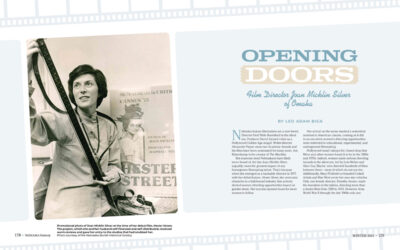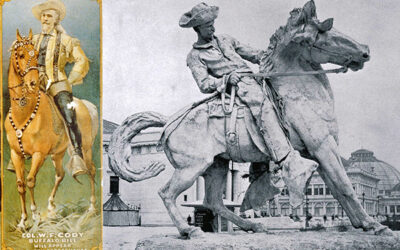Big news! We are transferring ownership of the Willa Cather State Historic Site and supporting collections to The Willa Cather Foundation.
By completing this transfer, our organizations have created the largest repository of Cather-related artifacts and ensured that Red Cloud and the new National Willa Cather Center will be a primary destination for all things Willa Cather.
After a several decade collaboration to preserve the sites and artifacts related to Pulitzer Prize-winning author, Willa Cather, History Nebraska and the Willa Cather Foundation announced the transfer of ownership of the Willa Cather State Historic Site to the Willa Cather Foundation. Located in Red Cloud, Nebraska—where Cather spent her formative years—six historic properties and supporting collections will be transferred to the Willa Cather Foundation. The properties were given to the State of Nebraska in 1978, and History Nebraska has worked cooperatively with the Willa Cather Foundation to operate the site since 1994.
The transfer of the historic sites and approximately 8,000 Cather related archival and museum artifacts, returns to local control the largest single collection of buildings devoted to an American author. Trevor Jones, Director and CEO of History Nebraska, says the transfer will help strengthen Cather’s legacy in Nebraska: “We are honored to have cared for these important properties for the last forty years. The Willa Cather Foundation is an excellent organization and by fully controlling this important historic site Willa Cather’s important legacy will be shared more extensively nationwide.”
The transfer supports the mission of the Willa Cather Foundation and will help ensure that the newly completed National Willa Cather Center will remain a primary location to learn about and research one of Nebraska’s most iconic writers with worldwide renown. Tourists and scholars from around the world visit Red Cloud because of its associations with Willa Cather.
In addition to overseeing a growing archive of Cather letters and photographs, the addition of these collections will make the National Willa Cather Center the largest repository for Cather-related artifacts. Included in the artifacts are tangible items that belonged to the Cather family, as well as furnishings, family book collections, and other possessions.
Ashley Olson, Executive Director of the Willa Cather Foundation, says the transfer will ensure a well-preserved tribute to a very private person. “We are grateful to History Nebraska and pleased to accept these important buildings and collections. Cather’s relationship with Red Cloud and its citizens was strong and enduring, so it seems fitting that visitors can uncover more about her life and work through site tours, exhibits, and research right here in Red Cloud.”
The following properties in the transfer are all on the National Register of Historic Places and open for guided tours regularly:
- Willa Cather’s Childhood Home, a National Historic Landmark, was the rented home to the Cather family after 1884 when they moved into town from an outlying farm. It is especially beloved because of Cather’s preserved bedroom under the eaves where she did her first writing and where the wallpaper that she selected, and purchased, still remains.
- The Antonia Farmhouse (the Pavelka Farmstead), about 15 miles north of Red Cloud. Anna Pavelka was the inspiration for Antonia in the novel, My Antonia, written in 1918. Cather had visited the Pavelkas there in 1916 and the last section of the novel is a description of the farm and its root cellar, also still on the farm site.
- The Farmers and Merchants Bank was built by Silas Garber, Red Cloud’s first citizen who incorporated the town in 1871. He was a prototype for Captain Forrester in Cather’s novel, A Lost Lady.
- The Grace Episcopal Church, which Cather joined in 1922 and was a member until her death. Two of the church’s painted glass windows were purchased by Cather in her parents’ memory.
- The St. Juliana Catholic Church, built in 1883, is the site of the marriage of Anna Sadilek Pavelka and her husband John Pavelka, prototypes for Antonia Shimerda and Anton Cuzak.
- The Burlington Depot, a building Cather became familiar with when returning to Red Cloud to visit friends and family. Depots, in general, played a significant role in Cather’s writings, symbolizing both escape to the world and the door through which the world came to Red Cloud.
Collections transferred include:
- Cather family furnishings and china
- First editions of Willa Cather’s books
- Hundreds of Cather family photographs and documents
- Nearly 200 personal letters written by Willa Cather
History Nebraska collects, preserves, and shares Nebraska’s history for all people. History Nebraska operates the Nebraska History Museum in Lincoln and historic sites around the state including Chimney Rock National Historic Site, Fort Robinson History Center, Neligh Mill State Historic Site, Thomas Kennard State Historic Site, Senator George Norris State Historic Site, John Neihardt State Historic Site, and over 500 historical markers placed across Nebraska. History Nebraska administers the State Archives and Library; the State Historic Preservation Office; the Gerald R. Ford Conservation Center; the Office of the State Archeologist; publishes Nebraska History Magazine and books; and is responsible for the administration of the Nebraska Hall of Fame Commission. More at https://historynegov.wpengine.com and follow us on Facebook, Instagram, and Twitter.
Founded in 1955, the Willa Cather Foundation is a 501(c)(3) not-for-profit organization that works to promote Willa Cather’s legacy through education, preservation, and the arts. The Foundation manages and provides guided tours of the nation’s largest collection of nationally designated historic sites dedicated to an America author and organizes the Willa Cather Spring Conference and International Cather Seminars to further Cather appreciation and scholarship. Arts and humanities programs are held regularly at the Foundation’s National Willa Cather Center and Red Cloud Opera House. The Foundation also publishes the Willa Cather Review, a leading source for Cather-related news, features, and scholarship. For more information, visit www.WillaCather.org or follow on Facebook @WillaCatherFoundation.



